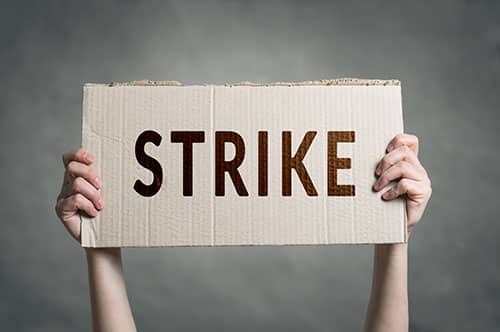In 2023, the United States witnessed a dramatic surge in labor strikes, a phenomenon not seen on such a scale for over two decades. As we move into 2024, the trend shows no signs of slowing down. Understanding the dynamics of strike threats is crucial for businesses, labor organizations, and policymakers alike. This article delves into the factors driving this wave of labor unrest, the industries most at risk, and strategies for both employers and unions to navigate these turbulent times.
The Surge in Labor Strikes: A Historical Context
The number of strikes in 2023 soared by 280% compared to the previous year, marking a significant resurgence in labor actions across various sectors. This uptick can be attributed to a confluence of economic, social, and technological factors. The COVID-19 pandemic, which initially suppressed labor movements due to economic uncertainties, eventually acted as a catalyst for the resurgence of union activities. Workers, particularly in essential industries like healthcare and manufacturing, became increasingly vocal about their working conditions, pay disparities, and the lack of adequate health and safety measures.
Additionally, the tightening labor market gave workers more leverage. With unemployment rates at historic lows, particularly in early 2023, employees found themselves in a stronger position to demand better terms. The rise of remote work and technological advancements also played a role, as many workers grew concerned about job security in the face of automation and AI-driven job displacement.
Key Industries and Notable Strikes
Several industries have become hotbeds of labor unrest, each with its unique set of challenges and drivers:
- Healthcare: The largest recorded healthcare strike in U.S. history occurred in October 2023 when over 75,000 Kaiser Permanente workers walked off the job. The strike highlighted issues like staffing shortages, burnout, and wage stagnation, which had been brewing long before the pandemic but were exacerbated by it. The resolution included significant wage increases and new initiatives to address staffing concerns, setting a precedent for other healthcare workers across the country.
- Automotive: The United Auto Workers (UAW) strikes against the “Big Three” automakers—General Motors, Ford, and Stellantis—were among the most consequential in 2023. Workers secured significant victories, including substantial wage hikes, the elimination of the controversial two-tier wage system, and commitments to safeguard jobs in the transition to electric vehicles. These strikes had ripple effects across the industry, with non-unionized competitors like Tesla and Toyota preemptively raising wages to stave off potential unrest.
- Entertainment: The entertainment industry also saw major disruptions, with both the Writers Guild of America (WGA) and the Screen Actors Guild (SAG-AFTRA) staging strikes that brought Hollywood to a standstill. These strikes were driven by concerns over residual payments, working conditions, and the use of AI in content creation. The WGA strike, which lasted over four months, ended with a historic agreement that addressed many of the writers’ demands, but tensions remain high as similar issues persist in the broader industry.
- Education: Graduate students and other academic workers have increasingly turned to strikes to address long-standing issues such as low pay, lack of job security, and inadequate benefits. The University of Michigan saw one of the longest and most contentious strikes in its history, with graduate students winning significant concessions after months of negotiations and legal battles.
Assessing Strike Risks: Indicators and Warning Signs
For businesses, the ability to assess the risk of a strike before it happens is crucial. Several indicators can signal an increased likelihood of labor unrest:
- Expired or Expiring Contracts: A significant number of strikes in 2023 were linked to the expiration of major labor contracts. When a contract is up for renewal, especially in industries with a history of labor disputes, the risk of a strike increases dramatically. Companies should closely monitor the progress of contract negotiations and be prepared for the possibility of walkouts.
- Worker Sentiment and Organizing Activity: The rise of social media and digital communication platforms has made it easier for workers to organize and express dissatisfaction. Monitoring these channels for signs of unrest can provide early warning signals. Increased union organizing activity, especially in non-unionized workplaces, is another key indicator of potential strikes.
- Economic Pressures: Inflation, cost of living increases, and economic downturns can all exacerbate labor tensions. In 2023, even as inflation began to cool, workers continued to feel the pinch, leading to more aggressive demands for wage increases and better benefits. Companies operating in industries with narrow profit margins may find themselves particularly vulnerable as they struggle to meet these demands.
- Technological Disruption: Industries undergoing rapid technological change, such as automation and AI adoption, are more prone to labor disputes. Workers concerned about job security are more likely to strike in an effort to secure protections against job displacement.
Strategies for Employers: Mitigating the Risk of Strikes
While it’s impossible to eliminate the risk of strikes entirely, employers can take proactive steps to reduce the likelihood and impact of labor disputes:
- Engage in Early and Transparent Communication: One of the most effective ways to prevent a strike is to address worker concerns before they escalate. Regular communication with employees, through surveys, town halls, and one-on-one meetings, can help identify and resolve issues early on.
- Invest in Fair Wages and Benefits: Compensation remains a primary driver of strikes. Ensuring that wages are competitive and keeping pace with inflation is crucial. Additionally, offering robust benefits packages, including healthcare, retirement contributions, and paid time off, can help improve worker satisfaction and loyalty.
- Enhance Employee Wellness and Work-Life Balance: Burnout and mental health concerns are increasingly leading to strikes, particularly in sectors like healthcare and education. Employers should prioritize employee wellness programs, offer flexible work arrangements, and ensure that staffing levels are sufficient to avoid overburdening employees.
- Train Managers in Conflict Resolution: Managers are often the first to hear about workplace issues, but they may not always have the skills to address them effectively. Providing training in conflict resolution, active listening, and communication can empower managers to resolve disputes before they escalate into strikes.
- Stay Informed on Labor Market Trends: Understanding broader labor market trends can help employers anticipate potential issues. Regularly reviewing data on wage growth, employment rates, and industry-specific challenges can provide valuable insights for strategic planning.
The Role of Unions: Balancing Advocacy and Collaboration
For unions, the challenge lies in balancing the need to advocate for workers’ rights with the practicalities of maintaining good relationships with employers. Strikes are a powerful tool, but they come with risks, including lost wages for workers and potential long-term damage to the employer-employee relationship.
- Building Solidarity and Public Support: Successful strikes often rely on strong solidarity among workers and broad public support. Unions should invest in organizing efforts, education campaigns, and public relations strategies to build a united front and garner sympathy from the broader community.
- Negotiating in Good Faith: While it’s important for unions to be firm in their demands, they should also be willing to negotiate in good faith. Compromise is often necessary to reach agreements that benefit both workers and employers.
- Preparing for the Long Haul: Strikes can last weeks or even months, as seen in some of the major disputes of 2023. Unions should ensure they have the resources to support workers during prolonged strikes, including strike funds and partnerships with community organizations.
- Leveraging Legal Protections: Workers’ rights to strike are protected under U.S. labor law, but these protections are not absolute. Unions must be aware of the legal landscape and prepared to defend their actions in court if necessary. Additionally, advocating for stronger labor laws at the state and federal levels can help protect workers’ rights in the long term.
The 2024 Outlook for Labor Strikes
As we move further into 2024, the factors that drove the surge in strikes in 2023 remain largely in place. Economic pressures, technological changes, and evolving worker expectations will continue to shape the labor landscape. Both employers and unions must be prepared to navigate this complex environment, with a focus on collaboration, communication, and strategic planning.
Strike threat assessment is more critical than ever in today’s volatile labor market. By understanding the underlying causes of labor unrest and implementing proactive strategies, both employers and unions can mitigate the risks and work towards more sustainable and equitable outcomes.









